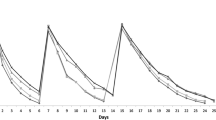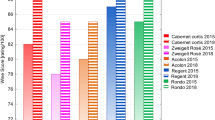Abstract
Three Southern Italy red wines Aglianico, Casavecchia and Pallagrello with high content of total tannins but different initial anthocyanins composition were aged in bottle for 15 months with closures allowing different degrees of wine oxygen exposure. In all wines oxygen exposure resulted in a progressive decrease in monomeric anthocyanins, vanillin reactive flavans and content of tannins reactive toward salivary proteins. In contrast, no significant decrease in color intensity was detected due to the formation of polymeric pigments. For all wines, the closure with the highest oxygen ingress determined a higher intensity of red fruit notes.


Similar content being viewed by others
References
Ritchey JG, Waterhouse AL (1999) A standard red wine: monomeric phenolic analysis of commercial Cabernet Sauvignon wines. Am J Enol Vitic 50(1):91–100
Fanzone M, Peña-Neira A, Gil M, Jofré V, Assof M, Zamora F (2012) Impact of phenolic and polysaccharidic composition on commercial value of Argentinean Malbec and Cabernet Sauvignon wines. Food Res Int 45(1):402–414
Arnold RA, Noble AC, Singleton VL (1980) Bitterness and astringency of phenolic fractions in wine. J Agric Food Chem 28(3):675–678
Robichaud JL, Noble AC (1990) Astringency and bitterness of selected phenolics in wine. J Sci Food Agric 53(3):343–353
Boulton R (2001) The copigmentation of anthocyanins and its role in the color of red wine: a critical review. Am J Enol Vitic 52(2):67–87
Atanasova V, Fulcrand H, Cheynier V, Moutounet M (2002) Effect of oxygenation on polyphenol changes occurring in the course of wine-making. Anal Chim Acta 458(1):15–27
Gambuti A, Rinaldi A, Ugliano M, Moio L (2013) Evolution of phenolic compounds and astringency during aging of red wine: effect of oxygen exposure before and after bottling. J Agric Food Chem 61(8):1618–1627
Nguyen DD, Nicolau L, Dykes SI, Kilmartin PA (2010) Influence of microoxygenation on reductive sulfur off-odors and color development in a Cabernet Sauvignon wine. Am J Enol Vitic 61(4):457–464
Caillé S, Samson A, Wirth J, Diéval JB, Vidal S, Cheynier V (2010) Sensory characteristics changes of red Grenache wines submitted to different oxygen exposures pre and post bottling. Anal Chim Acta 660(1):35–42
Wirth J, Morel-Salmi C, Souquet JM, Dieval JB, Aagaard O, Vidal S, Cheynier V (2010) The impact of oxygen exposure before and after bottling on the polyphenolic composition of red wines. Food Chem 123(1):107–116
Wirth J, Caillé S, Souquet JM, Samson A, Dieval JB, Vidal S, Cheynier V (2012) Impact of post-bottling oxygen exposure on the sensory characteristics and phenolic composition of Grenache rosé wines. Food Chem 132(4):1861–1871
Han G, Ugliano M, Currie B, Vidal S, Diéval JB, Waterhouse AL (2015) Influence of closure, phenolic levels and microoxygenation on Cabernet Sauvignon wine composition after 5 years’ bottle storage. J Sci Food Agric 95(1):36–43
Ugliano M, Dieval JB, Siebert TE, Kwiatkowski M, Aagaard O, Vidal S, Waters EJ (2012) Oxygen consumption and development of volatile sulfur compounds during bottle aging of two Shiraz wines. Influence of pre-and postbottling controlled oxygen exposure. J Agric Food Chem 60(35):8561–8570
Ugliano M (2013) Oxygen contribution to wine aroma evolution during bottle aging. J Agric Food Chem 61(26):6125–6136
Cano-López M, Pardo-Mínguez F, Schmauch G, Saucier C, Teissedre PL, López-Roca JM, Gómez-Plaza E (2008) Effect of micro-oxygenation on color and anthocyanin-related compounds of wines with different phenolic contents. J Agric Food Chem 56(14):5932–5941
Kwiatkowski MJ, Skouroumounis GK, Lattey KA, Waters EJ (2007) The impact of closures, including screw cap with three different headspace volumes, on the composition, colour and sensory properties of a Cabernet Sauvignon wine during two years’ storage. Aust J Grape and Wine Res 13(2):81–94
Chrysochou P, Krystallis A, Mocanu A, Leigh Lewis R (2012) Generation Y preferences for wine: an exploratory study of the US market applying the best-worst scaling. Br Food J 114(4):516–528
Rinaldi A, Jourdes M, Teissedre PL, Moio L (2014) A preliminary characterization of Aglianico (Vitis vinifera L. cv.) grape proanthocyanidins and evaluation of their reactivity towards salivary proteins. F Chem 164:142–149
Masi E, Vignani R, Di Giovannantonio A, Mancuso S, Boselli M (2001) Ampelographic and cultural characterisation of the Casavecchia variety. Adv Hortic Sci 15(1–4):47–55
Glories Y (1984) La couleur des vins rouges. 1° e 2° partie. Conn Vigne Vin 18:253–271
Di Stefano R, Guidoni S (1989) La determinazione dei polifenoli totali nei mosti e nei vini. Vignevini 16(12):47–52
Ribereau-Gayon P, Stonestreet E (1966) Le dosage des tanins du vin rouge et la determination de leur structure. Chim Anal 48:188–192
Harbertson JF, Picciotto EA, Adams DO (2003) Measurement of polymeric pigments in grape berry extract sand wines using a protein precipitation assay combined with bisulfite bleaching. Am J Enol Vitic 54(4):301–306
Rinaldi A, Gambuti A, Moio L (2012) Application of the SPI (Saliva Precipitation Index) to the evaluation of red wine astringency. Food Chem 135(4):2498–2504
King MC, Hall J, Cliff MA (2001) A comparison of methods for evaluating the performance of a trained sensory panel1. J Sens Stud 16(6):567–581
Elias RJ, Waterhouse AL (2010) Controlling the Fenton reaction in wine. J Agric Food Chem 58(3):1699–1707
Danilewicz JC, Seccombe JT, Whelan J (2008) Mechanism of interaction of polyphenols, oxygen, and sulfur dioxide in model wine and wine. Am J Enol Vitic 59(2):128–136
Ferreira V, Carrascón V, Bueno M, Ugliano M, Fernandez-Zurbano P (2015) Oxygen consumption by red wines. Part I: consumption rates, relationship with chemical composition and role of SO2. J Agric Food Chem 63(51):10928–10937
Barril C, Clark AC, Scollary GR (2012) Chemistry of ascorbic acid and sulfur dioxide as an antioxidant system relevant to white wine. Anal Chim Acta 732:186–193
Barril C, Rutledge DN, Scollary GR, Clark AC (2016) Ascorbic acid and white wine production: a review of beneficial versus detrimental impacts.Aust J Grape Wine Res. doi: 10.1111/ajgw.12207
Arapitsas P, Speri G, Angeli A, Perenzoni D, Mattivi F (2014) The influence of storage on the “chemical age” of red wines. Metabolomics 10(5):816–832
Daniel MA, Elsey GM, Capone DL, Perkins MV, Sefton MA (2004) Fate of damascenone in wine: the role of SO2. J Agric Food Chem 52(26):8127–8131
Boulton RB, Singleton VL, Bisson LF, Kunkee RE (1999) Principles and practices of winemaking. Springer, Berlin
Gómez-Míguez M, González-Manzano S, Escribano-Bailón MT, Heredia FJ, Santos-Buelga C (2006) Influence of different phenolic copigments on the color of malvidin 3-glucoside. J Agric Food Chem 54(15):5422–5429
Danilewicz JC (2014) Role of tartaric and malic acids in wine oxidation. J Agric Food Chem 62(22):5149–5155
Francis FJ, Markakis PC (1989) Food colorants: anthocyanins. Crit Rev Food Sci Nutr 28(4):273–314
Vivas N, Glories Y (1993) Les phénomènes d’oxydoréduction lies a l’élevage en barrique des vins rouges: aspects technologiques. Rev Franç d’oenologie 33(142):33–38
Boselli E, Boulton RB, Thorngate JH, Frega NG (2004) Chemical and sensory characterization of DOC red wines from Marche (Italy) related to vintage and grape cultivars. J Agric Food Chem 52(12):3843–3854
De Beer D, Harbertson JF, Kilmartin PA, Roginsky V, Barsukova T, Adams DO, Waterhouse AL (2004) Phenolics: a comparison of diverse analytical methods. Am J Enol Vitic 55(4):389–400
Versari A, Boulton RB, Parpinello GP (2007) Analysis of SO2-resistant polymeric pigments in red wines by High-Performance Liquid Chromatography. Am J Enol Vitic 58(4):523–525
Fulcrand H, Atanasova V, Salas E, Cheynier V (2004) The fate of anthocyanins in wine: are there determining factors? In:ACS symposium series, vol 886. Oxford University Press, 68–88
McRae JM, Kassara S, Kennedy JA, Waters EJ, Smith PA (2013) Effect of wine pH and bottle closure on tannins. J Agric Food Chem 61(47):11618–11627
Bindon KA, McCarthy MG, Smith PA (2014) Development of wine colour and non-bleachable pigments during the fermentation and ageing of (Vitis vinifera L. cv.) Cabernet Sauvignon wines differing in anthocyanin and tannin concentration. LWT-Food Sci Technol 59(2):923–932
McRae JM, Day MP, Bindon KA, Kassara S, Schmidt SA, Schulkin A, Smith PA (2015) Effect of early oxygen exposure on red wine colour and tannins. Tetrahedron 71(20):3131–3137
Mouls L, Fulcrand H (2012) UPLC-ESI-MS study of the oxidation markers released from tannin depolymerization: toward a better characterization of the tannin evolution over food and beverage processing. J Mass Spectrom 47(11):1450–1457
Poncet-Legrand C, Cabane B, Bautista-Ortín AB, Carrillo S, Fulcrand H, Pérez J, Vernhet A (2010) Tannin oxidation: intra-versus intermolecular reactions. Biomacromolecules 11(9):2376–2386
Vernhet A, Dubascoux S, Cabane B, Fulcrand H, Dubreucq E, Poncet-Legrand C (2011) Characterization of oxidized tannins: comparison of depolymerization methods, asymmetric flow field-flow fractionation and small-angle X-ray scattering. Anal Bioanal Chem 401(5):1559–1569
Mayén M, Mérida J, Medina M (1995) Flavonoid and non-flavonoid compounds during fermentation and post-fermentation standing of musts from Cabernet Sauvignon and Tempranillo grapes. Am J Enol Vitic 46(2):255–261
Bautista-Ortín AB, Fernández-Fernández JI, López-Roca JM, Gómez-Plaza E (2007) The effects of enological practices in anthocyanins, phenolic compounds and wine colour and their dependence on grape characteristics. J Food Compos Anal 20(7):546–552
Muccillo L, Gambuti A, Frusciante L, Iorizzo M, Moio L, Raieta K, Aversano R (2014) Biochemical features of native red wines and genetic diversity of the corresponding grape varieties from Campania region. Food Chem 143:506–513
He F, Pan QH, Shi Y, Duan CQ (2008) Chemical synthesis of proanthocyanidins in vitro and their reactions in aging wines. Molecules 13(12):3007–3032
Gambuti A, Han G, Peterson AL, Waterhouse AL (2015) Sulfur Dioxide and Glutathione Alter the Outcome of Microoxygenation. Am J Enol Vitic. doi:10.5344/ajev.2015.15005
Versari A, Toit W, Parpinello GP (2013) Oenological tannins: a review. Aust J Grape Wine Res 19(1):1–10
Danilewicz JC (2016) Reaction of oxygen and sulfite in wine. Am J Enol Vitic 67(1):13–17
Balboa-Lagunero T, Arroyo T, Cabellos JM, Aznar M (2011) Sensory and olfactometric profiles of red wines after natural and forced oxidation processes. Am J Enol Vitic 62(4):527–535
Roullier-Gall C, Witting M, Tziotis D, Ruf A, Lucio M, Schmitt-Kopplin P, Gougeon RD (2015) Advances in wine research. In: SE Ebeler, G Sacks, S Vidal, P Winterhalter (Eds.) American Chemical Society
Ferreira V, Bueno M, Franco-Luesma E, Culleré L, Fernández-Zurbano P (2014) Key changes in wine aroma active compounds during bottle storage of Spanish red wines under different oxygen levels. J Agric Food Chem 62(41):10015–10027
Acknowledgments
The study on the influence of closure oxygen permeability on phenolics, color, astringency markers and sensory attributes was financially supported by Nomacorc SA.
Author information
Authors and Affiliations
Corresponding author
Ethics declarations
Conflict of interest
The authors declare that they have no conflict of interest.
Compliance with ethics requirements
This article does not contain any studies with human or animal subjects.
Rights and permissions
About this article
Cite this article
Gambuti, A., Siani, T., Picariello, L. et al. Oxygen exposure of tannins-rich red wines during bottle aging. Influence on phenolics and color, astringency markers and sensory attributes. Eur Food Res Technol 243, 669–680 (2017). https://doi.org/10.1007/s00217-016-2780-3
Received:
Revised:
Accepted:
Published:
Issue Date:
DOI: https://doi.org/10.1007/s00217-016-2780-3




